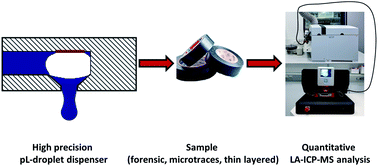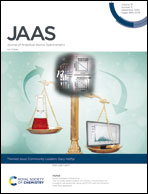Calibration of LA-ICP-MS via standard addition using dried picoliter droplets†
Abstract
A novel microanalytical calibration approach for quantitative spatially resolved analysis of thin layered materials with laser ablation-inductively coupled plasma-mass spectrometry (LA-ICP-MS) is presented. This method relies on standard addition via the generation of dried pL-droplet residues. Therefore, a drop on demand dosing device based on a modified commercial ink cartridge and a dosing interface, both accessible via a self-constructed microcontroller, were developed. This dosing device enables the precise deposition of pL-droplets onto solid samples for the generation of residues with dimensions in the low μm-range. The LA-ICP-MS analysis of such residues allows calibration over at least 6 orders of magnitude corresponding to absolute ablated masses, with limits of detection of a few fg. As this method is based on standard addition it is necessary to determine the ablated sample mass to calculate concentrations. The volume of the ablated sample material per ablation crater is determined via microscopical determination of the sample's thickness and of the ablation crater's diameter. The ablated sample mass is obtained via the ablated sample volume and the density of the sample material. The developed method was successfully used for the accurate determination of a selection of elements in a polymeric thin section and a glass cover slip. The performance of this approach regarding accuracy, uncertainty and repeatability is discussed herein.

- This article is part of the themed collection: Community Leaders: Gary Hieftje


 Please wait while we load your content...
Please wait while we load your content...